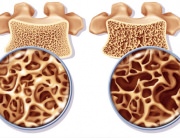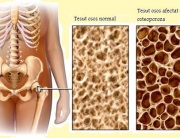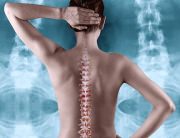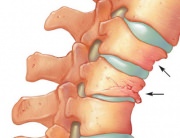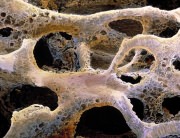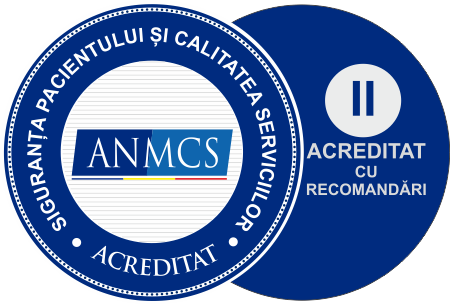 Human body bones are not static, as illustrated in specialty literature pictures. Bones continuously change throughout a person’s life, with certain bone cells that dissolve and new cells that develop as part of a process referred to as bone remodelling. Through this remodelling process, a large portion of the human skeleton is replaced every 10 years.
Human body bones are not static, as illustrated in specialty literature pictures. Bones continuously change throughout a person’s life, with certain bone cells that dissolve and new cells that develop as part of a process referred to as bone remodelling. Through this remodelling process, a large portion of the human skeleton is replaced every 10 years.
In osteoporotic persons, bone resorption is quicker than the development of the new bone tissue. The bones become porous, fragile and they are predisposed to fractures. The X-ray of a normal bone density hip shows a dense bone cell matrix. Quite on the contrary, the X-ray of an osteoporotic hip will mostly show an empty trabecular area. The bone matrix is almost entirely dissolved, with only a few remaining fibres.
Osteoporosis is also referred to as the “silent thief” that instils itself as years go by.
Bone density reaches its peak around the age of 20. As we grow older, several factors may cause bone mass loss. Osteoporosis or the early disorder that warns on the risks of osteoporosis, the osteopenia, signals an unbalance in the bone remodelling process: too much bone tissue is destroyed and too little bone tissue regenerates. This process causes bone fragility and a higher fracture risk.
You probably know that calcium is essential for strong bones, but an inadequate intake of calcium is not the only negative element. There are less known causes of osteoporosis. The experts in the field believe that bone mass loss is most often caused by a combination of several risk factors.
What Causes Osteoporosis? Low Estrogen In Women
What Is The Most Frequently Encountered Cause of Osteoporosis? In general t is caused by an estrogen deficiency in women. Bone resorption is accelerated during the postmenopausal, period, when elderly women suffer from a quick decrease of the estrogen level. In time, the risk of osteoporosis and, implicitly, of fractures increases as the bone tissue loss is higher than the replacement rate.
Young adult women who no longer have menstruation – such as very thin athletes or girls suffering from anorexia – have a compromised bone density. The surgical removal of both ovaries, referred to as bilateral ovariectomy, may also cause a low bone density and osteoporosis. A clinical trial has shown that this surgical intervention has led to an increase by 54% of hip, spine and wrist fractures in postmenopausal women.
What Causes Osteoporosis? Low Testosterone In Men
Male bone health requires both testosterone and estrogen. This is due to the fact that testosterone is converted into estrogen to protect the bones. There is a clear consensus that, when the health condition of men suffering from osteoporosis is assessed, testosterone deficiencies always need to be evaluated as well.
What Causes Osteoporosis? Other Hormonal Unbalances
There also hormones with a bone density adjustment role, including the parathyroid hormone (parathormone) si hormonul de crestere (somatotrope). These hormones determine the efficient use of calcium in the bone remodelling process. However, the parathormone excess, referred to as hyperparathyroidism, leads to increased calcium elimination through urine, to the detriment of its assimilation by the bone system. Calcium deficiency means weaker bones. At the same time, as we grow old, the body produces lower levels of somatotrope hormone, which is essential for strong bones.
What Causes Osteoporosis? Calcium Deficiency
The formation of new bone tissue as part of the permanent bone remodelling process is impossible without the calcium intake. The bones act as a reservoir for two minerals – calcium and phosphor. You need a constant level of calcium in your blood stream, considering that many of the organs are dependent upon calcium – the heart, the muscles, the nervous system. If these organs require calcium, they will assimilate it from the bone mineral deposit. In time, as this deposit becomes depleted, the bones will become thinner and more fragile.
What Causes Osteoporosis? Vitamin D Deficiency
Vitamin D deficiency may cause bone tissue loss and the weakening of the bones. The active vitamin D biological form, also referred to as calcitriol, is rather a hormone and not a vitamin, as stated by Paul Mystkowski. Amongst its numerous benefits, vitamin D also ensures the assimilation of the calcium in the body.
What Causes Osteoporosis? A Sedentary Lifestyle
Bones become weaker if they are not put to work. Remember the first astronauts? They were exposed to an accelerated bone tissue loss, caused by the lack of gravity in the space. People with a sedentary lifestyle or who suffer from paralysis or muscular dystrophy are exposed to an accelerated bone tissue loss. This osteoporosis cause may be prevented. You can remodel your bones through antigravity exercises that cause an average strain on the bones.
What Causes Osteoporosis? Thyroid Disorders
The high thyroid hormone level was, for quite some time, associated to an accelerated bone tissue loss. This factor was a permanent reason of concern for a number of doctors, but a long-term assessment of the bone density in patients taking high thyroid medicine doses shows that there is no important difference, and the fracture risk is not significantly higher. However, most doctors agree that any person with a high thyroid hormone level can benefit from physical exercise and from a sufficient calcium and vitamin D intake. These lifestyle-related factors are efficient methods to assess the fracture risk, as well as to monitor the bone density through laboratory tests.
What Causes Osteoporosis? Smoking
Smokers have a lower bone density and they are more predisposed to bone fractures as compared to non-smokers. The trials on smoking and bone density have, however, brought to light a number of negative effects, from the direct toxic effect of nicotine on the bone cells, to the inability of the body to assimilate estrogen, calcium and vitamin D.
What Causes Osteoporosis? Medication
The use of certain medication classes may cause the loss of bone tissue and an increased risk of fractures. The most common type of medication includes corticosteroids, also known as corticosteroids, also known as cortisone, hydrocortisone, glucocorticoids and prednisone. This medication is used to treat asthma, rheumatoid arthritis, psoriasis, colitis and a number of other disorders. Anticonvulsants are also associated to bone mass loss.
What Causes Osteoporosis? Medical Disorders
What Causes Osteoporosis? Excessive Alcohol Consumption
Alcohol can interrupt the bone modelling processes and it may increase the calcium loss. People who are under the influence of alcohol are exposed to an increased risk of fall and osteoporosis, in its turn, increases the bone fracture risk.
Bone health largely is under your control. Many of the causes of osteoporosis are lifestyle-related factors that you can largely influence – the calcium and vitamin D intake, exercising to strengthen the bones. However, if bone mass loss persists, contact you physician to assess the possible hormonal unbalances or identify the medical disorders causing this loss.
Osteoporosis Risk Factors:
- women are more predisposed to osteoporosis than men, and especially very thin, slender women, or elderly women;
- Caucasian or Asian women, especially those with a family history of osteoporosis, are more predisposed to this disease than women of other races;
- postmenopausal women, including women with precocious menopause, surgically-induced menopause, menstruation disorders or amenorrhea (the absence of menstruation);
- smoking, nutrition disorders, such as anorexia nervosa or bulimia, the low calcium intake, the excessive alcohol consumption, a sedentary lifestyle, the use of medicine such as anticonvulsants or corticosteroids;
- rheumatoid arthritis;
- family history, especially parents suffering from osteoporosis.

